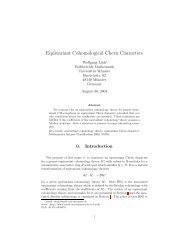Connes-Chern Character for Manifolds with Boundary and ETA ...
Connes-Chern Character for Manifolds with Boundary and ETA ...
Connes-Chern Character for Manifolds with Boundary and ETA ...
Create successful ePaper yourself
Turn your PDF publications into a flip-book with our unique Google optimized e-Paper software.
58 MATTHIAS LESCH, HENRI MOSCOVICI, AND MARKUS J. PFLAUM<br />
Given a de Rham current C of degree j then C defines naturally a cochain ˜C ∈<br />
C j ( b C ∞ (M)) by putting ˜C(a 0 , . . . , a j ) := 1 j! 〈C, a 0da 1 ∧ · · · ∧ da j 〉. One has b ˜C = 0 <strong>and</strong><br />
B ˜C = ˜∂C, where ∂ is the codifferential. Because of this identification we will from now<br />
on omit the ∼ from the notation if no confusion is possible.<br />
Given a closed b-differential <strong>for</strong>m ω on M of even degree. By C ω we denote the de<br />
Rham current ∫b ω ∧ −. There is a natural pullback M ι∗ ω at ∞ (cf. Definition <strong>and</strong><br />
Propostion 1.5), which is a closed even degree <strong>for</strong>m on ∂M. We now find<br />
∫<br />
∫<br />
∫<br />
〈∂C ω , α〉 = ω ∧ dα = d(ω ∧ α) = ι ∗ (ω ∧ α) =<br />
b M<br />
b M<br />
∂M<br />
∫<br />
(6.21)<br />
= ι ∗ (ω) ∧ ι ∗ (α) = 〈C ι ∗ ω, ι ∗ (α)〉.<br />
∂M<br />
In view of Subsection 1.2 this means that the pair (C ω , C ι ∗ ω) is a relative de Rham cycle<br />
or via the above mentioned identification between de Rham currents <strong>and</strong> cochains that<br />
(˜C ω , ˜C ι ∗ ω) is a relative cocycle in the relative total complex Eq. (6.14).<br />
If ω = ∑ j≥0 ω 2j <strong>with</strong> closed b-differential <strong>for</strong>ms of degree 2j then the pair (ω, ι ∗ ω)<br />
still gives rise to a relative cocycle of degree dim M in the relative total complex.<br />
These considerations certainly apply to the even degree <strong>for</strong>ms b ω D , ω D∂ which satisfy<br />
ι ∗ ( b ω) = ω D∂ . The limit results (6.18), (6.19), (6.5) can then be summarized as<br />
lim<br />
t→0+<br />
( b ˜ch<br />
k<br />
t (D), ch k−1<br />
t (D ∂ ) ) =<br />
( ∫b M<br />
∫<br />
b ω D ∧ −,<br />
∂M<br />
)<br />
ω D∂ ∧ − . (6.22)<br />
The limit on left is understood pointwise <strong>for</strong> each component of pure degree.<br />
Finally we need to relate ( k<br />
b ˜ch t (D), ch k−1<br />
t (D ∂ ) ) to the <strong>Chern</strong> character of [D] ∈<br />
K m (M, ∂M). First recall from Eq. (1.11) that HP •( C ∞ (M), C ∞ (∂M) ) is naturally<br />
isomorphic to HP •( J ∞ (∂M, M) ) . Under this isomorphism, the class of the<br />
pair ( k<br />
b ˜ch t (D), ch k−1<br />
t (D ∂ ) ) is mapped to b k<br />
˜ch t (D) |J ∞ (∂M,M), just because elements of<br />
J ∞ (∂M, M) vanish on ∂M. We note in passing that by (A.5) a smooth function f<br />
on M ◦ lies in J ∞ (∂M, M) iff in cylindrical coordinates one has <strong>for</strong> all l, R <strong>and</strong> every<br />
differential operator P on ∂M<br />
∂ l xDf(x, p) = O(e Rx ),<br />
x ↦→ −∞.<br />
In view of (6.17), the class of ( k<br />
b ˜ch t (D), ch k−1<br />
t (D ∂ ) ) in HP •( J ∞ (∂M, M) ) equals<br />
that of ˜Cb ω D<br />
. As explained in Section 1.8, HP •( J ∞ (∂M, M) ) is naturally isomorphic<br />
to H• dR (M, ∂M; C). Under this isomorphism, ˜Cb ω D<br />
corresponds to the relative<br />
de Rham cycle ( ) Cb ω D<br />
, C ωD∂ . Finally, note that under the Poincaré duality isomorphism<br />
H• dR (M, ∂M; C) ∼ = H dR • (M \ ∂M; C), the relative de Rham cycle ( )<br />
Cb ω D<br />
, C ωD∂<br />
is mapped onto the closed <strong>for</strong>m b ω D . This line of argument shows that the class of<br />
( k b ˜ch t (D), ch k−1<br />
t (D ∂ ) ) depends only on the absolute de Rham cohomology class of the<br />
closed <strong>for</strong>m b ω D = c·Â(b ∇g) 2 on the open manifold M \∂M. The transgression <strong>for</strong>mula<br />
in <strong>Chern</strong>–Weil theory shows that the (absolute) de Rham cohomology class of  ( )<br />
∇ 2 g<br />
is independent of the metric g on M ◦ . Thus the de Rham class of b ω D equals that of

















